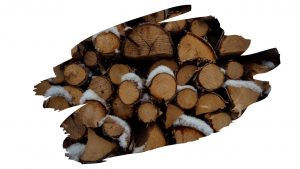When the nights get cold its important to make sure that you always have a stock of dry, seasoned wood that can heat your home and lower your monthly heating bill.
However, it is a year-round task; you can’t expect to season the wood a week before cold weather arrives.
Firewood requires anywhere from six months to two years to dry out. Therefore, you have to spend a lot of time preparing for winter.
But there are some basic things that you need to know first.
- Freshly chopped firewood has 50% water content.
- When the wood is cut, it is often green.
- Green or unseasoned wood doesn’t produce heat.
- The drier the wood, the cleaner the flame.
- Unseasoned wood can cause creosote build-up.
But despite all this, if you season wood correctly, you can completely eliminate your monthly heating bill.
So it is well worth learning how to season wood… just keep reading to discover how.

This post may contain affiliate links to products that we receive a commission for (at no additional cost to you). Learn more here.
What Is Seasoned Wood?
At the end of the day ‘Seasoned Wood‘ is simply firewood that doesn’t have moisture in it.
The seasoning process removes as much moisture as possible to improve its efficiency.
When the wood is seasoned properly, it releases much less smoke and thus is a lot cleaner (due to there being less soot). Whats more, if it is stored, it is not susceptible to decay or sap staining.
What Happens If You Burn Unseasoned Wood?
Burning unseasoned wood has many drawbacks.
First, it is hard to start and takes a lot of effort, and second, it can release an enormous amount of smoke.
The heat generated by the fire evaporates the water in the wood first which not only produces smoke and makes your chimney dirty, but also leaves less heat for your home.
Plus, the smoke released off of unseasoned wood impacts your family’s health.
For that reason, it is better to count on seasoned wood as it is a cleaner source of fuel
How To Season Wood | 7 Great Tips!
Plan ahead.
It can take up to 12 months for softwoods to season. So try to cut the wood by early spring if you plan on using it in winter.
Choose the right type of wood.
Its understandable that you may not always have the luxury of choosing what wood to use, but knowing the properties of the wood you’ve purchased helps in several ways.
For example, pine wood requires 6-12 months to season, on the other hand, oak wood can take up to a couple of years.
It doesn’t mean oak wood isn’t good for seasoning. Oak makes for great firewood and provides nearly twice as much heat.
The reason why it takes longer to the season, however, is due to its high density, (compared to pine and other types of softwood).
Splitting the wood is key.
Splitting the wood exposes the interior surface to air and sunlight. The air reaches all sides and speeds up the amount of time needed to dry the wood.
It also discourages wood-boring insect infestations.
After splitting the wood, it is time to gather and stack wood at the right time of the year.
There are a few tips you can follow for stacking success, such as, opt for the right site, as your wood will remain in ‘that’ specific spot for a long time. The site should also be convenient for grabbing firewood to bring indoors.
In areas with little rainfall in the summer, open-air storage is a good option. The shade-stored wood also dries, but it just takes longer.
Keep it off the ground always.
Direct contact with soil won’t remove the moisture in the wood. In fact, the wood will soak up more moisture from the earth and get bugs and fungus as well.
You can get a firewood rack to elevate wood. It enables air to flow beneath wood and dry it faster.

Keep seasoned wood covered if your area gets heavy rainfall.
There are two theories on the covering of wood; you have to decide which suits you the most.
The first theory is to cover the stack well to prevent rain or snow from entering the center of the rick.
Not sure about how much wood you can expect to get from a rick? Don’t worry, I explain all in the post: ‘Woodworking 101: How Much Wood Will I Get In A Rick?’ Simply click here now to learn more.
The second theory is not to cover your wood at all. Supporters of the second theory believe leaving your wood out there without any shelter doesn’t affect the seasoning process. It seasons just as well as if you cover it. In case it is tough to decide which theory suits your region, divide your wood, and try experimenting with both ways.
If you opt to purchase seasoned wood, store it in an open-sided shed.
This will help keep the moisture content to between 10 and 20 percent.
How Can You Tell If Wood Is Seasoned?
- The wood looks less vibrant when compared to green unseasoned wood.
- It makes a hollow sound instead of a dull thud when two pieces are hit together.
- When you burn a test piece, it doesn’t create a lot of smoke.
- The weight difference is noticeable; it becomes lighter.
- As we have mentioned before, the moisture-level is between 10 and 20 percent.
- It is easy to remove the bark.
- The dry or seasoned wood is compressed and stronger.
Final Thoughts
Remember, seasoned wood doesn’t last forever.
It starts to decay after four to five years. In order to save money, you can buy green wood in advance and season it yourself. Though make sure you are buying it in spring or early summer so that it can be seasoned on time.
Also, don’t forget to ask about the type of wood you are getting. This is important when working out how long it will take to season the wood.
For example, white oak and red oak take a year for proper seasoning, but they produces a high amount of heat and they burns slowly too.
On the contrary, the ash wood also produces a high amount of heat, however, it doesn’t need to be seasoned as long as oak wood.

![Will A Polyurethane Coat Ever Dry In Cold Weather? [What You Need To Know] will polyurethane dry in cold weather](https://www.thewoodworkplace.com/wp-content/uploads/2022/11/Banner-521-150x150.jpg)
![Will Tacky Wood Stain Eventually Dry? [What To Do When Stain Is Not Drying] will tacky stain eventually dry](https://www.thewoodworkplace.com/wp-content/uploads/2022/10/Banner-502-150x150.jpg)
![Will Polyurethane Ever Dry In A High Humidity Environment? [Revealed!] will polyurethane dry in high humidity](https://www.thewoodworkplace.com/wp-content/uploads/2022/11/Banner-522-150x150.jpg)